Investigating Parental Separation's Impact on School Engagement
VerifiedAdded on 2022/12/22
|11
|3458
|1
Report
AI Summary
This research proposal investigates the impact of parental separation on school engagement during the middle school years in South Australia. The study focuses on the research question: How is school engagement influenced by parental separation during middle school years in South Australia? The background and significance section highlights the importance of this research, emphasizing the potential negative impacts of parental separation on children's development and academic performance. A literature review analyzes existing studies on the topic, identifying a gap in research specific to South Australia. The methodology outlines the use of both secondary and primary data collection methods, including a review of existing literature and the distribution of questionnaires using a Likert scale. Data analysis will involve descriptive and inferential statistical methods. The sampling structure targets families in South Australia who have experienced separation, with a stratified random sampling method used to select participants. Ethical considerations, including voluntary participation, informed consent, and confidentiality, are addressed. The aim is to understand the effects of parental separation, filling a research gap within the South Australian context.

Impact of Parental Separation on School Engagement
With reference to Middle School Years in South Australia
Student Details
6/17/2019
With reference to Middle School Years in South Australia
Student Details
6/17/2019
Paraphrase This Document
Need a fresh take? Get an instant paraphrase of this document with our AI Paraphraser

PARENTAL SEPARATION IMPACT ON SCHOOL ENGAGEMENT
Contents
RESEARCH QUESTION...........................................................................................................................3
BACKGROUND & SIGNIFICANCE........................................................................................................3
Significance of the research.....................................................................................................................3
Literature Review....................................................................................................................................4
METHODOLOGY......................................................................................................................................5
Data Collection Method...........................................................................................................................5
Data Analysis Method.............................................................................................................................6
SAMPLING STRUCTURE........................................................................................................................7
Sampling Method....................................................................................................................................8
Access to Sample.....................................................................................................................................8
ETHICS.......................................................................................................................................................8
Voluntary Participation............................................................................................................................9
Informed consent.....................................................................................................................................9
Confidentiality.........................................................................................................................................9
REFERENCES..........................................................................................................................................10
2
Contents
RESEARCH QUESTION...........................................................................................................................3
BACKGROUND & SIGNIFICANCE........................................................................................................3
Significance of the research.....................................................................................................................3
Literature Review....................................................................................................................................4
METHODOLOGY......................................................................................................................................5
Data Collection Method...........................................................................................................................5
Data Analysis Method.............................................................................................................................6
SAMPLING STRUCTURE........................................................................................................................7
Sampling Method....................................................................................................................................8
Access to Sample.....................................................................................................................................8
ETHICS.......................................................................................................................................................8
Voluntary Participation............................................................................................................................9
Informed consent.....................................................................................................................................9
Confidentiality.........................................................................................................................................9
REFERENCES..........................................................................................................................................10
2
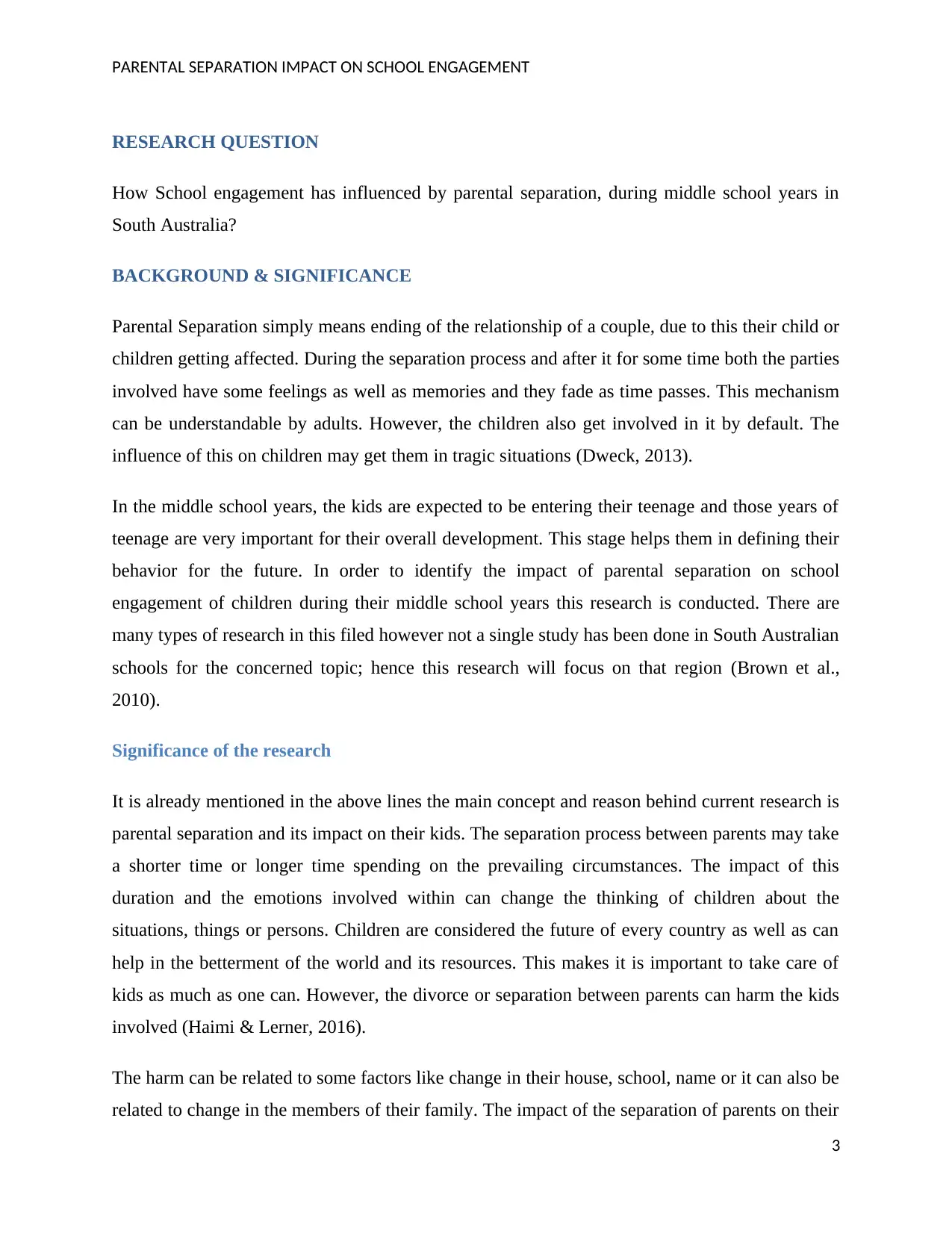
PARENTAL SEPARATION IMPACT ON SCHOOL ENGAGEMENT
RESEARCH QUESTION
How School engagement has influenced by parental separation, during middle school years in
South Australia?
BACKGROUND & SIGNIFICANCE
Parental Separation simply means ending of the relationship of a couple, due to this their child or
children getting affected. During the separation process and after it for some time both the parties
involved have some feelings as well as memories and they fade as time passes. This mechanism
can be understandable by adults. However, the children also get involved in it by default. The
influence of this on children may get them in tragic situations (Dweck, 2013).
In the middle school years, the kids are expected to be entering their teenage and those years of
teenage are very important for their overall development. This stage helps them in defining their
behavior for the future. In order to identify the impact of parental separation on school
engagement of children during their middle school years this research is conducted. There are
many types of research in this filed however not a single study has been done in South Australian
schools for the concerned topic; hence this research will focus on that region (Brown et al.,
2010).
Significance of the research
It is already mentioned in the above lines the main concept and reason behind current research is
parental separation and its impact on their kids. The separation process between parents may take
a shorter time or longer time spending on the prevailing circumstances. The impact of this
duration and the emotions involved within can change the thinking of children about the
situations, things or persons. Children are considered the future of every country as well as can
help in the betterment of the world and its resources. This makes it is important to take care of
kids as much as one can. However, the divorce or separation between parents can harm the kids
involved (Haimi & Lerner, 2016).
The harm can be related to some factors like change in their house, school, name or it can also be
related to change in the members of their family. The impact of the separation of parents on their
3
RESEARCH QUESTION
How School engagement has influenced by parental separation, during middle school years in
South Australia?
BACKGROUND & SIGNIFICANCE
Parental Separation simply means ending of the relationship of a couple, due to this their child or
children getting affected. During the separation process and after it for some time both the parties
involved have some feelings as well as memories and they fade as time passes. This mechanism
can be understandable by adults. However, the children also get involved in it by default. The
influence of this on children may get them in tragic situations (Dweck, 2013).
In the middle school years, the kids are expected to be entering their teenage and those years of
teenage are very important for their overall development. This stage helps them in defining their
behavior for the future. In order to identify the impact of parental separation on school
engagement of children during their middle school years this research is conducted. There are
many types of research in this filed however not a single study has been done in South Australian
schools for the concerned topic; hence this research will focus on that region (Brown et al.,
2010).
Significance of the research
It is already mentioned in the above lines the main concept and reason behind current research is
parental separation and its impact on their kids. The separation process between parents may take
a shorter time or longer time spending on the prevailing circumstances. The impact of this
duration and the emotions involved within can change the thinking of children about the
situations, things or persons. Children are considered the future of every country as well as can
help in the betterment of the world and its resources. This makes it is important to take care of
kids as much as one can. However, the divorce or separation between parents can harm the kids
involved (Haimi & Lerner, 2016).
The harm can be related to some factors like change in their house, school, name or it can also be
related to change in the members of their family. The impact of the separation of parents on their
3
⊘ This is a preview!⊘
Do you want full access?
Subscribe today to unlock all pages.

Trusted by 1+ million students worldwide
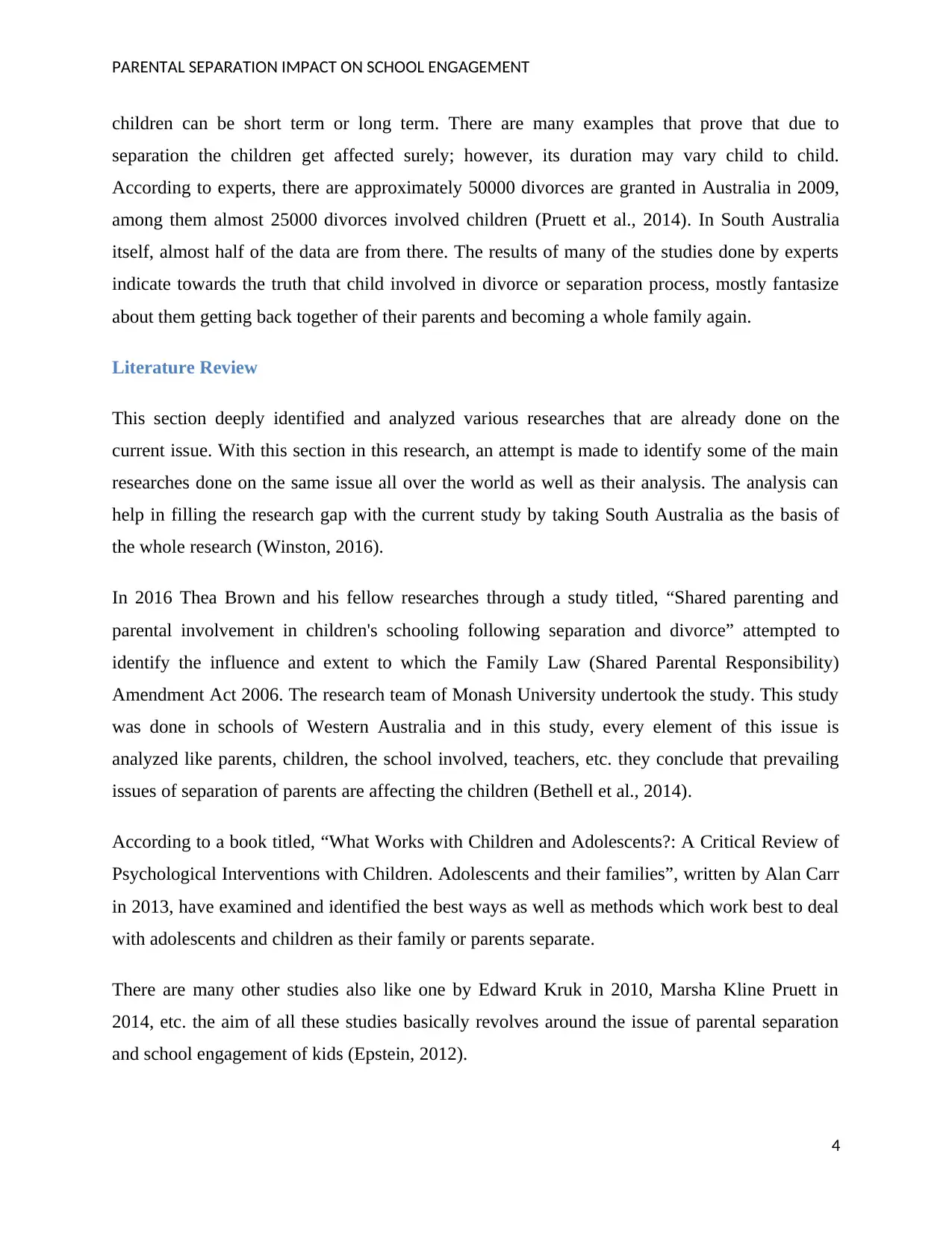
PARENTAL SEPARATION IMPACT ON SCHOOL ENGAGEMENT
children can be short term or long term. There are many examples that prove that due to
separation the children get affected surely; however, its duration may vary child to child.
According to experts, there are approximately 50000 divorces are granted in Australia in 2009,
among them almost 25000 divorces involved children (Pruett et al., 2014). In South Australia
itself, almost half of the data are from there. The results of many of the studies done by experts
indicate towards the truth that child involved in divorce or separation process, mostly fantasize
about them getting back together of their parents and becoming a whole family again.
Literature Review
This section deeply identified and analyzed various researches that are already done on the
current issue. With this section in this research, an attempt is made to identify some of the main
researches done on the same issue all over the world as well as their analysis. The analysis can
help in filling the research gap with the current study by taking South Australia as the basis of
the whole research (Winston, 2016).
In 2016 Thea Brown and his fellow researches through a study titled, “Shared parenting and
parental involvement in children's schooling following separation and divorce” attempted to
identify the influence and extent to which the Family Law (Shared Parental Responsibility)
Amendment Act 2006. The research team of Monash University undertook the study. This study
was done in schools of Western Australia and in this study, every element of this issue is
analyzed like parents, children, the school involved, teachers, etc. they conclude that prevailing
issues of separation of parents are affecting the children (Bethell et al., 2014).
According to a book titled, “What Works with Children and Adolescents?: A Critical Review of
Psychological Interventions with Children. Adolescents and their families”, written by Alan Carr
in 2013, have examined and identified the best ways as well as methods which work best to deal
with adolescents and children as their family or parents separate.
There are many other studies also like one by Edward Kruk in 2010, Marsha Kline Pruett in
2014, etc. the aim of all these studies basically revolves around the issue of parental separation
and school engagement of kids (Epstein, 2012).
4
children can be short term or long term. There are many examples that prove that due to
separation the children get affected surely; however, its duration may vary child to child.
According to experts, there are approximately 50000 divorces are granted in Australia in 2009,
among them almost 25000 divorces involved children (Pruett et al., 2014). In South Australia
itself, almost half of the data are from there. The results of many of the studies done by experts
indicate towards the truth that child involved in divorce or separation process, mostly fantasize
about them getting back together of their parents and becoming a whole family again.
Literature Review
This section deeply identified and analyzed various researches that are already done on the
current issue. With this section in this research, an attempt is made to identify some of the main
researches done on the same issue all over the world as well as their analysis. The analysis can
help in filling the research gap with the current study by taking South Australia as the basis of
the whole research (Winston, 2016).
In 2016 Thea Brown and his fellow researches through a study titled, “Shared parenting and
parental involvement in children's schooling following separation and divorce” attempted to
identify the influence and extent to which the Family Law (Shared Parental Responsibility)
Amendment Act 2006. The research team of Monash University undertook the study. This study
was done in schools of Western Australia and in this study, every element of this issue is
analyzed like parents, children, the school involved, teachers, etc. they conclude that prevailing
issues of separation of parents are affecting the children (Bethell et al., 2014).
According to a book titled, “What Works with Children and Adolescents?: A Critical Review of
Psychological Interventions with Children. Adolescents and their families”, written by Alan Carr
in 2013, have examined and identified the best ways as well as methods which work best to deal
with adolescents and children as their family or parents separate.
There are many other studies also like one by Edward Kruk in 2010, Marsha Kline Pruett in
2014, etc. the aim of all these studies basically revolves around the issue of parental separation
and school engagement of kids (Epstein, 2012).
4
Paraphrase This Document
Need a fresh take? Get an instant paraphrase of this document with our AI Paraphraser
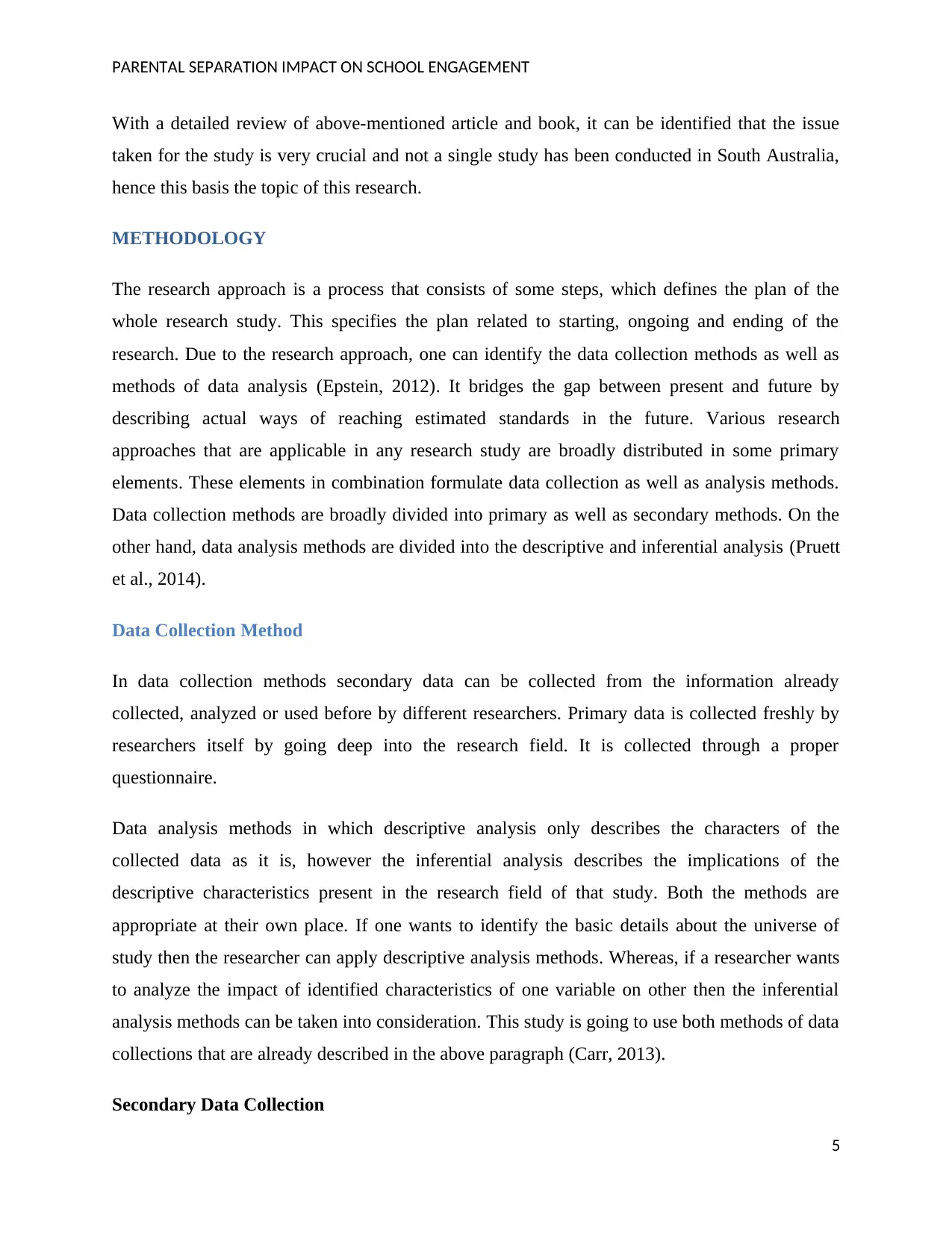
PARENTAL SEPARATION IMPACT ON SCHOOL ENGAGEMENT
With a detailed review of above-mentioned article and book, it can be identified that the issue
taken for the study is very crucial and not a single study has been conducted in South Australia,
hence this basis the topic of this research.
METHODOLOGY
The research approach is a process that consists of some steps, which defines the plan of the
whole research study. This specifies the plan related to starting, ongoing and ending of the
research. Due to the research approach, one can identify the data collection methods as well as
methods of data analysis (Epstein, 2012). It bridges the gap between present and future by
describing actual ways of reaching estimated standards in the future. Various research
approaches that are applicable in any research study are broadly distributed in some primary
elements. These elements in combination formulate data collection as well as analysis methods.
Data collection methods are broadly divided into primary as well as secondary methods. On the
other hand, data analysis methods are divided into the descriptive and inferential analysis (Pruett
et al., 2014).
Data Collection Method
In data collection methods secondary data can be collected from the information already
collected, analyzed or used before by different researchers. Primary data is collected freshly by
researchers itself by going deep into the research field. It is collected through a proper
questionnaire.
Data analysis methods in which descriptive analysis only describes the characters of the
collected data as it is, however the inferential analysis describes the implications of the
descriptive characteristics present in the research field of that study. Both the methods are
appropriate at their own place. If one wants to identify the basic details about the universe of
study then the researcher can apply descriptive analysis methods. Whereas, if a researcher wants
to analyze the impact of identified characteristics of one variable on other then the inferential
analysis methods can be taken into consideration. This study is going to use both methods of data
collections that are already described in the above paragraph (Carr, 2013).
Secondary Data Collection
5
With a detailed review of above-mentioned article and book, it can be identified that the issue
taken for the study is very crucial and not a single study has been conducted in South Australia,
hence this basis the topic of this research.
METHODOLOGY
The research approach is a process that consists of some steps, which defines the plan of the
whole research study. This specifies the plan related to starting, ongoing and ending of the
research. Due to the research approach, one can identify the data collection methods as well as
methods of data analysis (Epstein, 2012). It bridges the gap between present and future by
describing actual ways of reaching estimated standards in the future. Various research
approaches that are applicable in any research study are broadly distributed in some primary
elements. These elements in combination formulate data collection as well as analysis methods.
Data collection methods are broadly divided into primary as well as secondary methods. On the
other hand, data analysis methods are divided into the descriptive and inferential analysis (Pruett
et al., 2014).
Data Collection Method
In data collection methods secondary data can be collected from the information already
collected, analyzed or used before by different researchers. Primary data is collected freshly by
researchers itself by going deep into the research field. It is collected through a proper
questionnaire.
Data analysis methods in which descriptive analysis only describes the characters of the
collected data as it is, however the inferential analysis describes the implications of the
descriptive characteristics present in the research field of that study. Both the methods are
appropriate at their own place. If one wants to identify the basic details about the universe of
study then the researcher can apply descriptive analysis methods. Whereas, if a researcher wants
to analyze the impact of identified characteristics of one variable on other then the inferential
analysis methods can be taken into consideration. This study is going to use both methods of data
collections that are already described in the above paragraph (Carr, 2013).
Secondary Data Collection
5
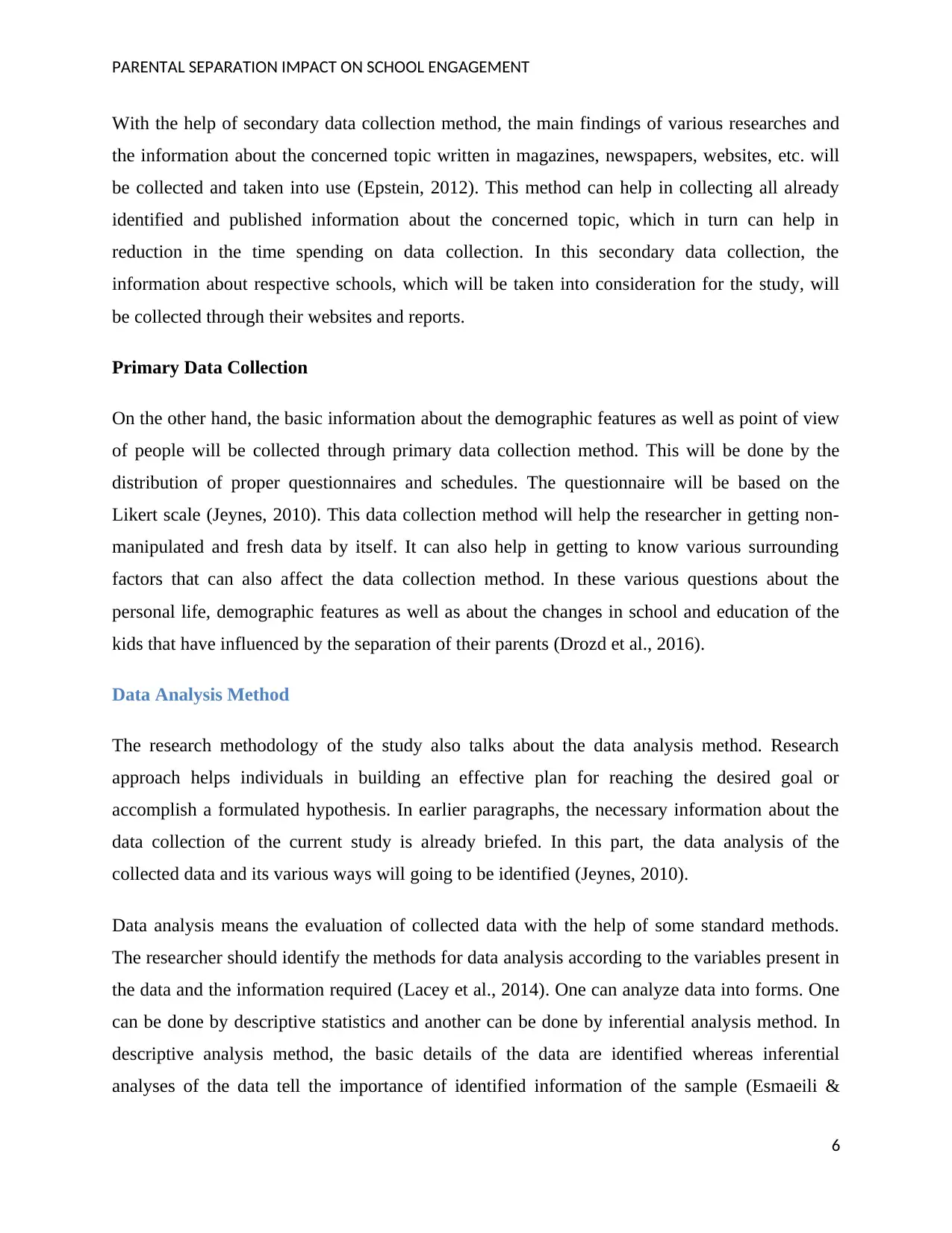
PARENTAL SEPARATION IMPACT ON SCHOOL ENGAGEMENT
With the help of secondary data collection method, the main findings of various researches and
the information about the concerned topic written in magazines, newspapers, websites, etc. will
be collected and taken into use (Epstein, 2012). This method can help in collecting all already
identified and published information about the concerned topic, which in turn can help in
reduction in the time spending on data collection. In this secondary data collection, the
information about respective schools, which will be taken into consideration for the study, will
be collected through their websites and reports.
Primary Data Collection
On the other hand, the basic information about the demographic features as well as point of view
of people will be collected through primary data collection method. This will be done by the
distribution of proper questionnaires and schedules. The questionnaire will be based on the
Likert scale (Jeynes, 2010). This data collection method will help the researcher in getting non-
manipulated and fresh data by itself. It can also help in getting to know various surrounding
factors that can also affect the data collection method. In these various questions about the
personal life, demographic features as well as about the changes in school and education of the
kids that have influenced by the separation of their parents (Drozd et al., 2016).
Data Analysis Method
The research methodology of the study also talks about the data analysis method. Research
approach helps individuals in building an effective plan for reaching the desired goal or
accomplish a formulated hypothesis. In earlier paragraphs, the necessary information about the
data collection of the current study is already briefed. In this part, the data analysis of the
collected data and its various ways will going to be identified (Jeynes, 2010).
Data analysis means the evaluation of collected data with the help of some standard methods.
The researcher should identify the methods for data analysis according to the variables present in
the data and the information required (Lacey et al., 2014). One can analyze data into forms. One
can be done by descriptive statistics and another can be done by inferential analysis method. In
descriptive analysis method, the basic details of the data are identified whereas inferential
analyses of the data tell the importance of identified information of the sample (Esmaeili &
6
With the help of secondary data collection method, the main findings of various researches and
the information about the concerned topic written in magazines, newspapers, websites, etc. will
be collected and taken into use (Epstein, 2012). This method can help in collecting all already
identified and published information about the concerned topic, which in turn can help in
reduction in the time spending on data collection. In this secondary data collection, the
information about respective schools, which will be taken into consideration for the study, will
be collected through their websites and reports.
Primary Data Collection
On the other hand, the basic information about the demographic features as well as point of view
of people will be collected through primary data collection method. This will be done by the
distribution of proper questionnaires and schedules. The questionnaire will be based on the
Likert scale (Jeynes, 2010). This data collection method will help the researcher in getting non-
manipulated and fresh data by itself. It can also help in getting to know various surrounding
factors that can also affect the data collection method. In these various questions about the
personal life, demographic features as well as about the changes in school and education of the
kids that have influenced by the separation of their parents (Drozd et al., 2016).
Data Analysis Method
The research methodology of the study also talks about the data analysis method. Research
approach helps individuals in building an effective plan for reaching the desired goal or
accomplish a formulated hypothesis. In earlier paragraphs, the necessary information about the
data collection of the current study is already briefed. In this part, the data analysis of the
collected data and its various ways will going to be identified (Jeynes, 2010).
Data analysis means the evaluation of collected data with the help of some standard methods.
The researcher should identify the methods for data analysis according to the variables present in
the data and the information required (Lacey et al., 2014). One can analyze data into forms. One
can be done by descriptive statistics and another can be done by inferential analysis method. In
descriptive analysis method, the basic details of the data are identified whereas inferential
analyses of the data tell the importance of identified information of the sample (Esmaeili &
6
⊘ This is a preview!⊘
Do you want full access?
Subscribe today to unlock all pages.

Trusted by 1+ million students worldwide
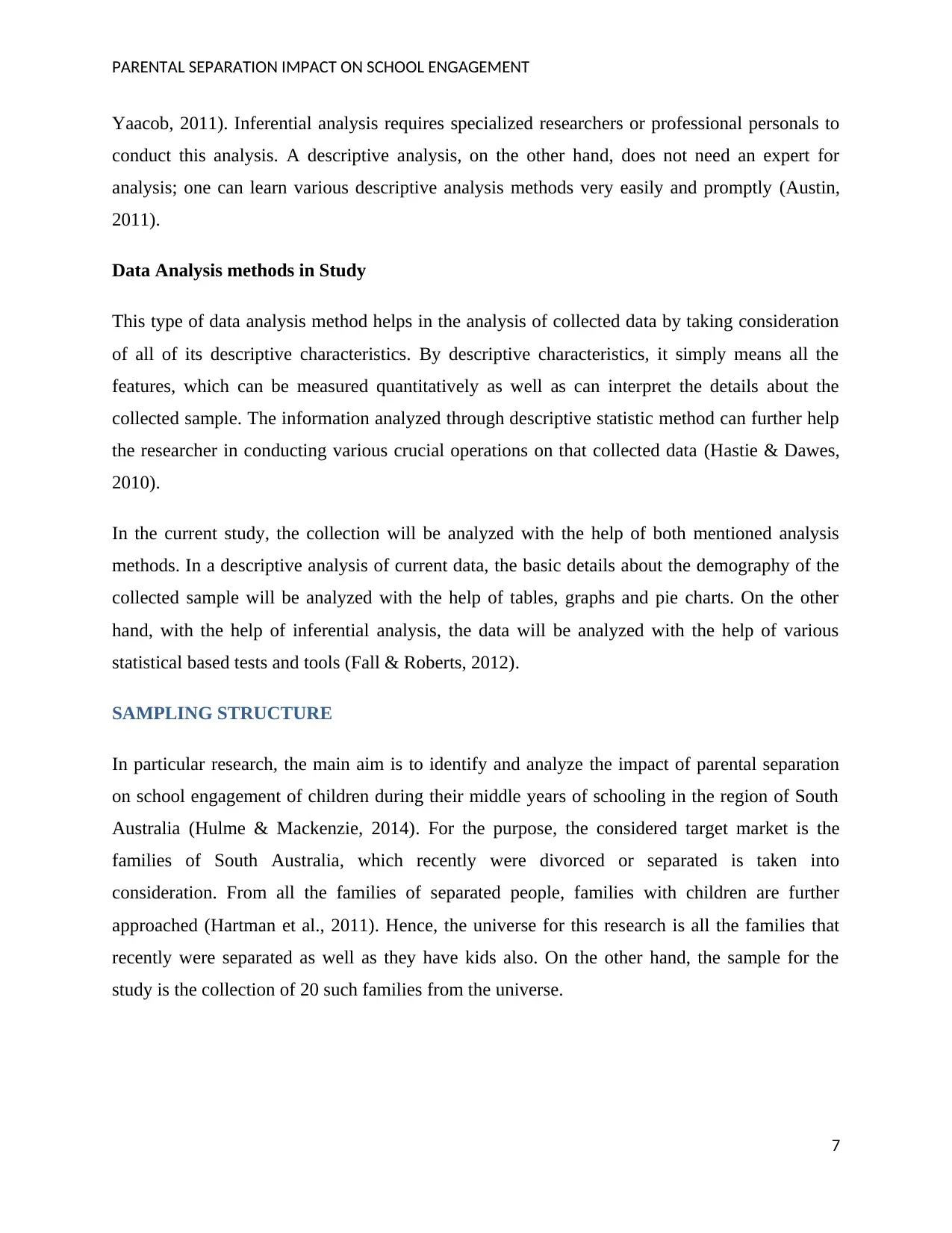
PARENTAL SEPARATION IMPACT ON SCHOOL ENGAGEMENT
Yaacob, 2011). Inferential analysis requires specialized researchers or professional personals to
conduct this analysis. A descriptive analysis, on the other hand, does not need an expert for
analysis; one can learn various descriptive analysis methods very easily and promptly (Austin,
2011).
Data Analysis methods in Study
This type of data analysis method helps in the analysis of collected data by taking consideration
of all of its descriptive characteristics. By descriptive characteristics, it simply means all the
features, which can be measured quantitatively as well as can interpret the details about the
collected sample. The information analyzed through descriptive statistic method can further help
the researcher in conducting various crucial operations on that collected data (Hastie & Dawes,
2010).
In the current study, the collection will be analyzed with the help of both mentioned analysis
methods. In a descriptive analysis of current data, the basic details about the demography of the
collected sample will be analyzed with the help of tables, graphs and pie charts. On the other
hand, with the help of inferential analysis, the data will be analyzed with the help of various
statistical based tests and tools (Fall & Roberts, 2012).
SAMPLING STRUCTURE
In particular research, the main aim is to identify and analyze the impact of parental separation
on school engagement of children during their middle years of schooling in the region of South
Australia (Hulme & Mackenzie, 2014). For the purpose, the considered target market is the
families of South Australia, which recently were divorced or separated is taken into
consideration. From all the families of separated people, families with children are further
approached (Hartman et al., 2011). Hence, the universe for this research is all the families that
recently were separated as well as they have kids also. On the other hand, the sample for the
study is the collection of 20 such families from the universe.
7
Yaacob, 2011). Inferential analysis requires specialized researchers or professional personals to
conduct this analysis. A descriptive analysis, on the other hand, does not need an expert for
analysis; one can learn various descriptive analysis methods very easily and promptly (Austin,
2011).
Data Analysis methods in Study
This type of data analysis method helps in the analysis of collected data by taking consideration
of all of its descriptive characteristics. By descriptive characteristics, it simply means all the
features, which can be measured quantitatively as well as can interpret the details about the
collected sample. The information analyzed through descriptive statistic method can further help
the researcher in conducting various crucial operations on that collected data (Hastie & Dawes,
2010).
In the current study, the collection will be analyzed with the help of both mentioned analysis
methods. In a descriptive analysis of current data, the basic details about the demography of the
collected sample will be analyzed with the help of tables, graphs and pie charts. On the other
hand, with the help of inferential analysis, the data will be analyzed with the help of various
statistical based tests and tools (Fall & Roberts, 2012).
SAMPLING STRUCTURE
In particular research, the main aim is to identify and analyze the impact of parental separation
on school engagement of children during their middle years of schooling in the region of South
Australia (Hulme & Mackenzie, 2014). For the purpose, the considered target market is the
families of South Australia, which recently were divorced or separated is taken into
consideration. From all the families of separated people, families with children are further
approached (Hartman et al., 2011). Hence, the universe for this research is all the families that
recently were separated as well as they have kids also. On the other hand, the sample for the
study is the collection of 20 such families from the universe.
7
Paraphrase This Document
Need a fresh take? Get an instant paraphrase of this document with our AI Paraphraser

PARENTAL SEPARATION IMPACT ON SCHOOL ENGAGEMENT
Sampling Method
Sampling is the process of collecting the required sample from the large population, which is
taken into consideration for research purpose. Sample can be said as a piece of the whole
universe of study. The process of collecting a sample from the universe of study is known as the
sample (Esmaeili & Yaacob, 2011). In this research study, the selected sampling method is
Stratified Simple Random Sampling Method. This method is taken into consideration as the
whole universe of study is distributed into different strata. First South Australia is taken as strata,
it is further divided into separated and divorced couples, and then it further divided into couples
with kids and couple without kids. Then from separated couples with kids 20 samples are
selected randomly (Kruk, 2010).
Access to Sample
In order to conduct a study on the selected sample, it is important to identify the way of reaching
to desired sample as well as way of collecting required information from them. it is crucial for
any researcher to identify sampling methods for its study, however, the identification of the way
of reaching the desired sample is also important. It can be a big challenge for many of the
researchers, as this involves lots of thinking, permission, patience, and hard work. In order to
conduct research and collect data from the desired sample the researcher first formulate a well-
structured questionnaire then it should identify the ways of distributing those questionnaires
among its desired sample (Wang & Eccles, 2012). Before distribution, it is important to take
consent from the governing body of the desired sample, in order to avoid any post research
allegations.
ETHICS
The researches about different issues bring various types of opportunities, challenges, and
questions in their field and others also. However, the practices involved in the research process
may intentionally or unintentionally be able to affect the research, sample units as well as
researcher in a drastic way (Yu et al., 2010). Hence, this brings the involvement of ethics in
research practices. Many ground principles and moral duties are involved in the research process.
8
Sampling Method
Sampling is the process of collecting the required sample from the large population, which is
taken into consideration for research purpose. Sample can be said as a piece of the whole
universe of study. The process of collecting a sample from the universe of study is known as the
sample (Esmaeili & Yaacob, 2011). In this research study, the selected sampling method is
Stratified Simple Random Sampling Method. This method is taken into consideration as the
whole universe of study is distributed into different strata. First South Australia is taken as strata,
it is further divided into separated and divorced couples, and then it further divided into couples
with kids and couple without kids. Then from separated couples with kids 20 samples are
selected randomly (Kruk, 2010).
Access to Sample
In order to conduct a study on the selected sample, it is important to identify the way of reaching
to desired sample as well as way of collecting required information from them. it is crucial for
any researcher to identify sampling methods for its study, however, the identification of the way
of reaching the desired sample is also important. It can be a big challenge for many of the
researchers, as this involves lots of thinking, permission, patience, and hard work. In order to
conduct research and collect data from the desired sample the researcher first formulate a well-
structured questionnaire then it should identify the ways of distributing those questionnaires
among its desired sample (Wang & Eccles, 2012). Before distribution, it is important to take
consent from the governing body of the desired sample, in order to avoid any post research
allegations.
ETHICS
The researches about different issues bring various types of opportunities, challenges, and
questions in their field and others also. However, the practices involved in the research process
may intentionally or unintentionally be able to affect the research, sample units as well as
researcher in a drastic way (Yu et al., 2010). Hence, this brings the involvement of ethics in
research practices. Many ground principles and moral duties are involved in the research process.
8
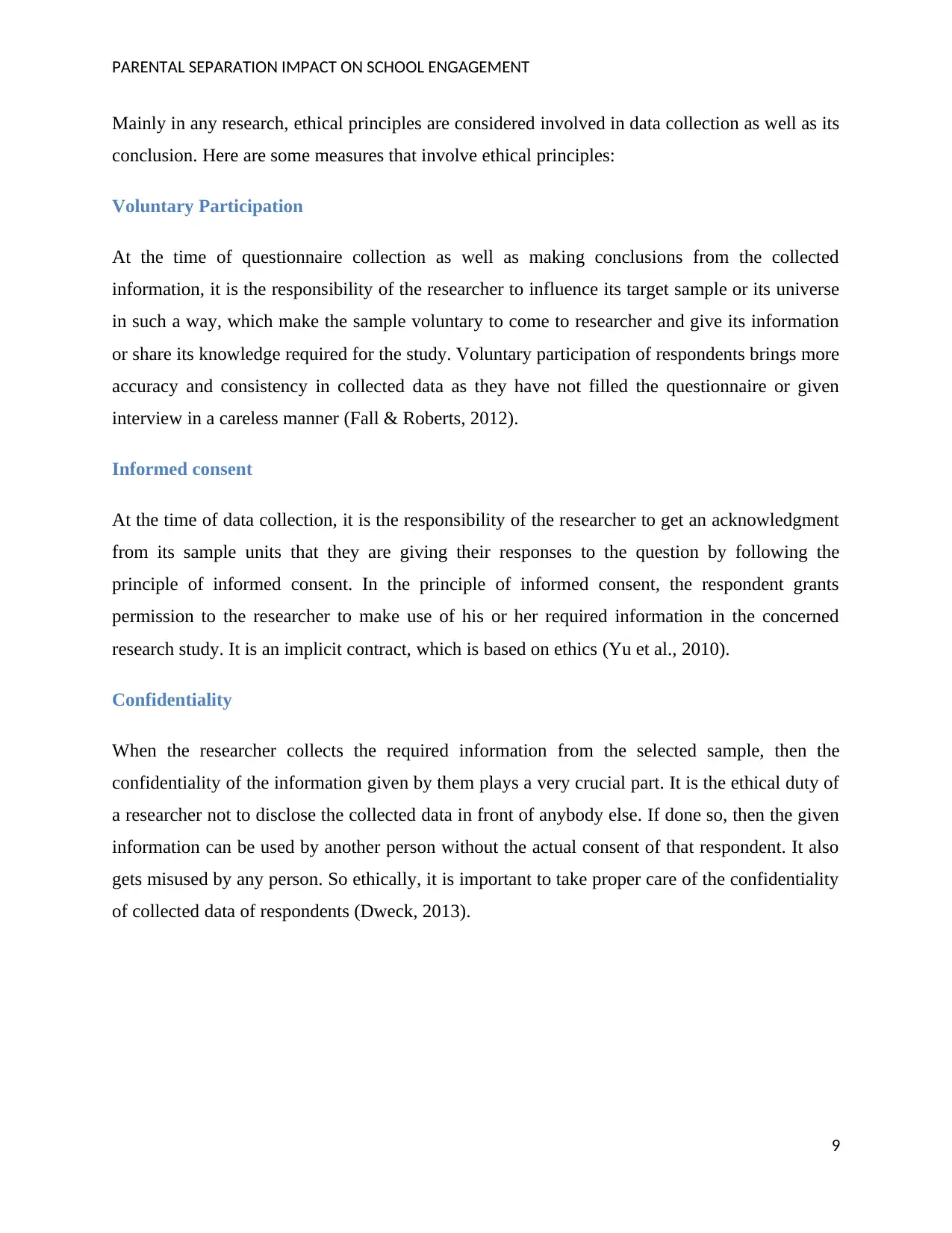
PARENTAL SEPARATION IMPACT ON SCHOOL ENGAGEMENT
Mainly in any research, ethical principles are considered involved in data collection as well as its
conclusion. Here are some measures that involve ethical principles:
Voluntary Participation
At the time of questionnaire collection as well as making conclusions from the collected
information, it is the responsibility of the researcher to influence its target sample or its universe
in such a way, which make the sample voluntary to come to researcher and give its information
or share its knowledge required for the study. Voluntary participation of respondents brings more
accuracy and consistency in collected data as they have not filled the questionnaire or given
interview in a careless manner (Fall & Roberts, 2012).
Informed consent
At the time of data collection, it is the responsibility of the researcher to get an acknowledgment
from its sample units that they are giving their responses to the question by following the
principle of informed consent. In the principle of informed consent, the respondent grants
permission to the researcher to make use of his or her required information in the concerned
research study. It is an implicit contract, which is based on ethics (Yu et al., 2010).
Confidentiality
When the researcher collects the required information from the selected sample, then the
confidentiality of the information given by them plays a very crucial part. It is the ethical duty of
a researcher not to disclose the collected data in front of anybody else. If done so, then the given
information can be used by another person without the actual consent of that respondent. It also
gets misused by any person. So ethically, it is important to take proper care of the confidentiality
of collected data of respondents (Dweck, 2013).
9
Mainly in any research, ethical principles are considered involved in data collection as well as its
conclusion. Here are some measures that involve ethical principles:
Voluntary Participation
At the time of questionnaire collection as well as making conclusions from the collected
information, it is the responsibility of the researcher to influence its target sample or its universe
in such a way, which make the sample voluntary to come to researcher and give its information
or share its knowledge required for the study. Voluntary participation of respondents brings more
accuracy and consistency in collected data as they have not filled the questionnaire or given
interview in a careless manner (Fall & Roberts, 2012).
Informed consent
At the time of data collection, it is the responsibility of the researcher to get an acknowledgment
from its sample units that they are giving their responses to the question by following the
principle of informed consent. In the principle of informed consent, the respondent grants
permission to the researcher to make use of his or her required information in the concerned
research study. It is an implicit contract, which is based on ethics (Yu et al., 2010).
Confidentiality
When the researcher collects the required information from the selected sample, then the
confidentiality of the information given by them plays a very crucial part. It is the ethical duty of
a researcher not to disclose the collected data in front of anybody else. If done so, then the given
information can be used by another person without the actual consent of that respondent. It also
gets misused by any person. So ethically, it is important to take proper care of the confidentiality
of collected data of respondents (Dweck, 2013).
9
⊘ This is a preview!⊘
Do you want full access?
Subscribe today to unlock all pages.

Trusted by 1+ million students worldwide

PARENTAL SEPARATION IMPACT ON SCHOOL ENGAGEMENT
REFERENCES
Austin, W.G., 2011. Parental Gatekeeping in Custody Disputes: Mutual Parental Support in
Divorce. American Journal of Family Law, 25(4), pp.148-53.
Bethell, C.D., Newacheck, P., Hawes, E. & Halfon, N., 2014. Adverse Childhood Experiences:
Assessing The Impact On Health And School Engagement And The Mitigating Role Of
Resilience. Health Affairs, 33(12), pp.2106-15.
Brown, T., Lundgren, A., Stevens, L.-M. & Boadle, J., 2010. Shared parenting and parental
involvement in children's schooling following separation and divorce. Children Australia, 35(1),
pp.7-13.
Carr, A., 2013. What Works with Children and Adolescents?: A Critical Review of Psychological
Interventions with Children, Adolescents, and their Families. Routledge.
Drozd, L., Saini, M. & Olesen, N., 2016. Parenting Plan Evaluations: Applied Research for the
Family Court. 2nd ed. Oxford University Press.
Dweck, C.S., 2013. Self-theories. 1st ed. New York: Psychology Press.
Epstein, S., 2012. Cognitive‐Experiential Self‐Theory: An Integrative Theory of Personality.
Personality and Social Psychology, 5.
Esmaeili, N.S. & Yaacob, S.N., 2011. Post-Divorce Parental Conflict and Adolescents’
Delinquency in Divorced Families. Asian Culture and History, 3(2), pp.34-40.
Fall, A.M. & Roberts, G., 2012. High school dropouts: Interactions between social context, self-
perceptions, school engagement, and student dropout. Journal of Adolescence, 35(4), pp.787-98.
Haimi, M. & Lerner, A., 2016. The Impact of Parental Separation and Divorce on the Health
Status of Children, and the Ways to Improve it. Journal of Clinical & Medical Genomics, pp.1-7.
Hartman, L.R., Magalhães, L. & Mandich, A., 2011. What Does Parental Divorce or Marital
Separation Mean for Adolescents? A Scoping Review of North American Literature. Journal of
Divorce & Remarriage, 52(7), pp.490-518.
10
REFERENCES
Austin, W.G., 2011. Parental Gatekeeping in Custody Disputes: Mutual Parental Support in
Divorce. American Journal of Family Law, 25(4), pp.148-53.
Bethell, C.D., Newacheck, P., Hawes, E. & Halfon, N., 2014. Adverse Childhood Experiences:
Assessing The Impact On Health And School Engagement And The Mitigating Role Of
Resilience. Health Affairs, 33(12), pp.2106-15.
Brown, T., Lundgren, A., Stevens, L.-M. & Boadle, J., 2010. Shared parenting and parental
involvement in children's schooling following separation and divorce. Children Australia, 35(1),
pp.7-13.
Carr, A., 2013. What Works with Children and Adolescents?: A Critical Review of Psychological
Interventions with Children, Adolescents, and their Families. Routledge.
Drozd, L., Saini, M. & Olesen, N., 2016. Parenting Plan Evaluations: Applied Research for the
Family Court. 2nd ed. Oxford University Press.
Dweck, C.S., 2013. Self-theories. 1st ed. New York: Psychology Press.
Epstein, S., 2012. Cognitive‐Experiential Self‐Theory: An Integrative Theory of Personality.
Personality and Social Psychology, 5.
Esmaeili, N.S. & Yaacob, S.N., 2011. Post-Divorce Parental Conflict and Adolescents’
Delinquency in Divorced Families. Asian Culture and History, 3(2), pp.34-40.
Fall, A.M. & Roberts, G., 2012. High school dropouts: Interactions between social context, self-
perceptions, school engagement, and student dropout. Journal of Adolescence, 35(4), pp.787-98.
Haimi, M. & Lerner, A., 2016. The Impact of Parental Separation and Divorce on the Health
Status of Children, and the Ways to Improve it. Journal of Clinical & Medical Genomics, pp.1-7.
Hartman, L.R., Magalhães, L. & Mandich, A., 2011. What Does Parental Divorce or Marital
Separation Mean for Adolescents? A Scoping Review of North American Literature. Journal of
Divorce & Remarriage, 52(7), pp.490-518.
10
Paraphrase This Document
Need a fresh take? Get an instant paraphrase of this document with our AI Paraphraser
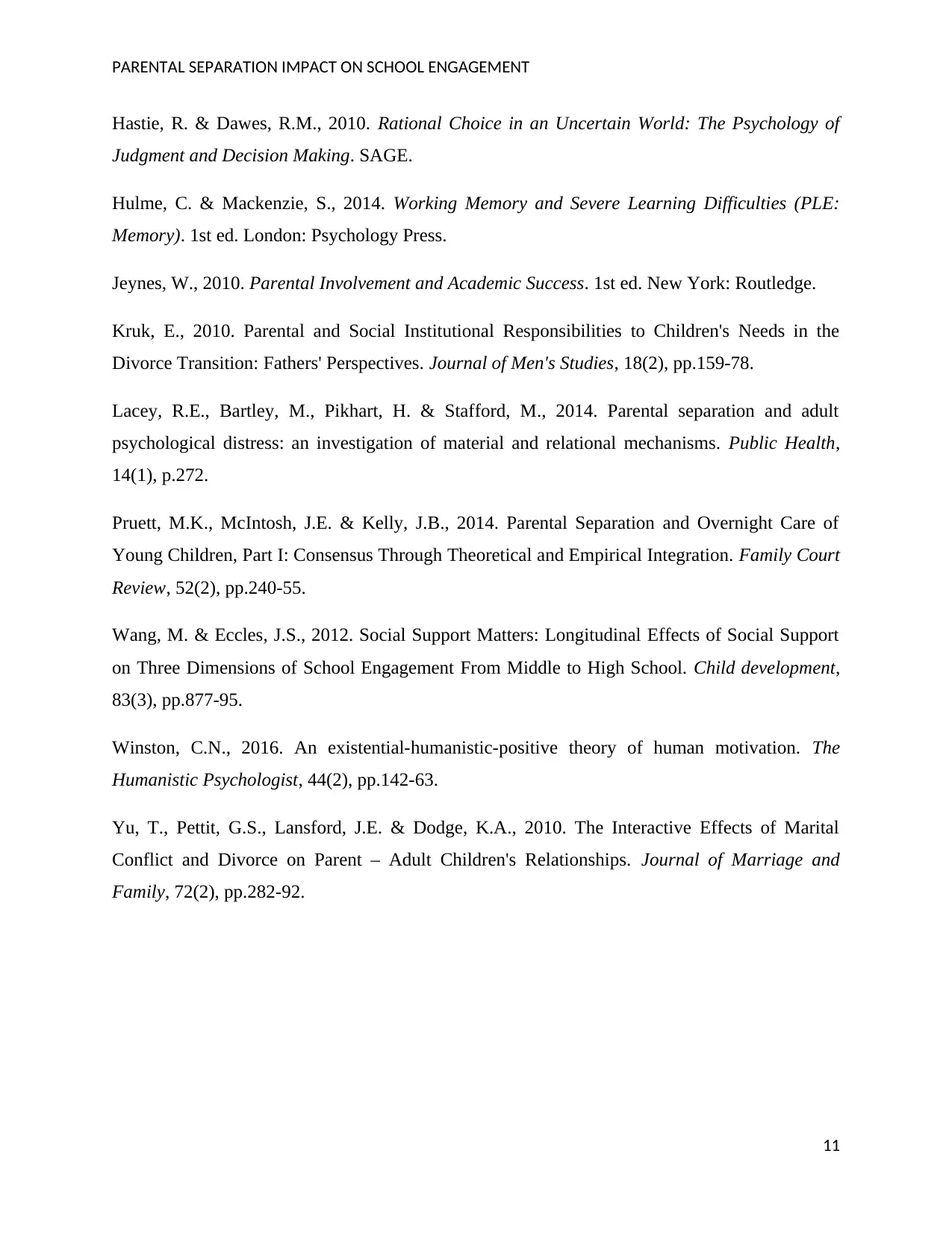
PARENTAL SEPARATION IMPACT ON SCHOOL ENGAGEMENT
Hastie, R. & Dawes, R.M., 2010. Rational Choice in an Uncertain World: The Psychology of
Judgment and Decision Making. SAGE.
Hulme, C. & Mackenzie, S., 2014. Working Memory and Severe Learning Difficulties (PLE:
Memory). 1st ed. London: Psychology Press.
Jeynes, W., 2010. Parental Involvement and Academic Success. 1st ed. New York: Routledge.
Kruk, E., 2010. Parental and Social Institutional Responsibilities to Children's Needs in the
Divorce Transition: Fathers' Perspectives. Journal of Men's Studies, 18(2), pp.159-78.
Lacey, R.E., Bartley, M., Pikhart, H. & Stafford, M., 2014. Parental separation and adult
psychological distress: an investigation of material and relational mechanisms. Public Health,
14(1), p.272.
Pruett, M.K., McIntosh, J.E. & Kelly, J.B., 2014. Parental Separation and Overnight Care of
Young Children, Part I: Consensus Through Theoretical and Empirical Integration. Family Court
Review, 52(2), pp.240-55.
Wang, M. & Eccles, J.S., 2012. Social Support Matters: Longitudinal Effects of Social Support
on Three Dimensions of School Engagement From Middle to High School. Child development,
83(3), pp.877-95.
Winston, C.N., 2016. An existential-humanistic-positive theory of human motivation. The
Humanistic Psychologist, 44(2), pp.142-63.
Yu, T., Pettit, G.S., Lansford, J.E. & Dodge, K.A., 2010. The Interactive Effects of Marital
Conflict and Divorce on Parent – Adult Children's Relationships. Journal of Marriage and
Family, 72(2), pp.282-92.
11
Hastie, R. & Dawes, R.M., 2010. Rational Choice in an Uncertain World: The Psychology of
Judgment and Decision Making. SAGE.
Hulme, C. & Mackenzie, S., 2014. Working Memory and Severe Learning Difficulties (PLE:
Memory). 1st ed. London: Psychology Press.
Jeynes, W., 2010. Parental Involvement and Academic Success. 1st ed. New York: Routledge.
Kruk, E., 2010. Parental and Social Institutional Responsibilities to Children's Needs in the
Divorce Transition: Fathers' Perspectives. Journal of Men's Studies, 18(2), pp.159-78.
Lacey, R.E., Bartley, M., Pikhart, H. & Stafford, M., 2014. Parental separation and adult
psychological distress: an investigation of material and relational mechanisms. Public Health,
14(1), p.272.
Pruett, M.K., McIntosh, J.E. & Kelly, J.B., 2014. Parental Separation and Overnight Care of
Young Children, Part I: Consensus Through Theoretical and Empirical Integration. Family Court
Review, 52(2), pp.240-55.
Wang, M. & Eccles, J.S., 2012. Social Support Matters: Longitudinal Effects of Social Support
on Three Dimensions of School Engagement From Middle to High School. Child development,
83(3), pp.877-95.
Winston, C.N., 2016. An existential-humanistic-positive theory of human motivation. The
Humanistic Psychologist, 44(2), pp.142-63.
Yu, T., Pettit, G.S., Lansford, J.E. & Dodge, K.A., 2010. The Interactive Effects of Marital
Conflict and Divorce on Parent – Adult Children's Relationships. Journal of Marriage and
Family, 72(2), pp.282-92.
11
1 out of 11
Related Documents
Your All-in-One AI-Powered Toolkit for Academic Success.
+13062052269
info@desklib.com
Available 24*7 on WhatsApp / Email
![[object Object]](/_next/static/media/star-bottom.7253800d.svg)
Unlock your academic potential
Copyright © 2020–2025 A2Z Services. All Rights Reserved. Developed and managed by ZUCOL.





